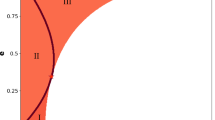Abstract
A new fully numerical method is presented which employs multiple Poincaré sections to find quasiperiodic orbits of the Restricted Three-Body Problem (RTBP). The main advantages of this method are the small overhead cost of programming and very fast execution times, robust behavior near chaotic regions that leads to full convergence for given family of quasiperiodic orbits and the minimal memory required to store these orbits. This method reduces the calculations required for searching two-dimensional invariant tori to a search for closed orbits, which are the intersection of the invariant tori with the Poincaré sections. Truncated Fourier series are employed to represent these closed orbits. The flow of the differential equation on the invariant tori is reduced to maps between the consecutive Poincaré maps. A Newton iteration scheme utilizes the invariance of the circles of the maps on these Poincaré sections in order to find the Fourier coefficients that define the circles to any given accuracy. A continuation procedure that uses the incremental behavior of the Fourier coefficients between close quasiperiodic orbits is utilized to extend the results from a single orbit to a family of orbits. Quasi-halo and Lissajous families of the Sun–Earth RTBP around the L2 libration point are obtained via this method. Results are compared with the existing literature. A numerical method to transform these orbits from the RTBP model to the real ephemeris model of the Solar System is introduced and applied.
Similar content being viewed by others
References
Ascher U., Christiansen J., Russell R.D.: Collocation software for boundary-value ODEs. ACM Trans. Math. Softw. 7, 209–222 (1981)
Ascher U., Mattheij R.M.M., Russell R.D.: Numerical Solution of Boundary Value Problems for Ordinary Differential Equations. Prentice-Hall, Englewood Cliffs, NJ (1988)
Barden B.T., Howell K.C.: Formation flying in the vicinity of libration point orbits. Adv. Astronaut. Sci. Spacefl. Mech. 99, 969–989 (1998)
Barden B.T., Howell K.C.: Dynamical issues associted with relative configurations of multiple spacecraft near the Sun–Earth/Moon L1 point. Adv. Astronaut. Sci. Astrodyn. 103, 2307–2327 (1999)
Boyd J.P., Xu F.: Divergence (Runge Phenomenon) for least-squares polynomial approximation on an equispaced grid and Mock-Chebyshev subset interpolation. Appl. Math. Comput. 210(1), 158–168 (2009)
Breakwell J.V., Brown J.: The Halo family of three dimensional periodic orbits in the Earth–Moon restricted three body problem. Celest. Mech. 20(4), 389–404 (1979)
Cash J.R., Wright M.H.: Implementation issues in solving nonlinear equations for two-point boundary value problems. Computing 55, 17–37 (1990)
Cash J.R., Wright M.H.: A deferred correction method for nonlinear two-point boundary value problems: implementation and numerical evaluation. SIAM J. Sci. Stat. Comput. 12, 971–989 (1991)
Dormand J.R., Prince P.J.: High order embedded Runge-Kutta formulae. J. Comput. Appl. Math. 7(1), 67–75 (1981)
Farquhar R.W.: Lunar Communications with Libration–Point Satellites. J. Spacecr. Rocket. 4(10), 1383–1384 (1967)
Farquhar R.W., Kamel A.A.: Quasi-periodic orbits about the translunar libration point. Celest. Mech. 7(4), 458–473 (1973)
Gómez, G., Jorba, À., Masdemont, J.J., Simó, C.: Dynamics and Mission Design Near Libration Point Orbits—Volume 3: Advanced Methods for Collinear Points. World Scientific, Singapore (2000)
Gómez G., Koon W.S., Lo M.W., Marsden J.E., Masdemont J., Ross S.D.: Connecting orbits and invariant manifolds in the spatial restricted three-body problem. Nonlinearity 17, 1571–1606 (2004)
Gómez, G., Llibre, J., Martínez, R., Simó, C.: Dynamics and Mission Design Near Libration Point Orbits—Volume 1: Fundamentals: The Case of Collinear Libration Points. World Scientific (2000)
Gómez G., Masdemont J.J., Simó C.: Quasihalo orbits associated with libration points. J. Astronaut. Sci. 46(2), 1–42 (1999)
Gómez G., Mondelo J.M.: The dynamics around the collinear equilibrium points of the RTBP. Physica D 157(4), 283–321 (2001)
Hénon M.: Vertical stability of periodic orbits in the restricted problem I. Equal Masses. Astron. Astrophys. 28, 415–426 (1973)
Howell K.C.: Three dimensional periodic Halo orbits. Celest. Mech. 32(1), 53–72 (1984)
Howell K.C., Pernicka H.J.: Numerical determination of Lissajous trajectories in the restricted three-body problem. Celest. Mech. 41(1–4), 107–124 (1988)
Masdemont J.J., Masdemont J.J.: Dynamics in the center manifold of the restricted three-body problem. Physica D 132, 189–213 (1999)
Villanueva J., Villanueva J.: Numerical computation of normal forms around some periodic orbits of the restricted three body problem. Physica D 114, 197–229 (1998)
Kevrekidis I.G., Aris R., Schmidt L.D., Pelikan S.: Numerical computations of invariant circles of maps. Physica D 16, 243–251 (1985)
Kierzenka J., Shampine L.F.: A BVP solver based on residual control and the matlab PSE. ACM Trans. Math. Softw. 27(3), 299–316 (2001)
Mondelo, J.M.: Contribution to the Study of Fourier Methods for Quasi-Periodic Functions and the Vicinity of the Collinear Libration Points. PhD thesis, Universitat de Barcelona, Departament de Matemàtica Aplicada i Anàlisi (2001)
Murray C.D., Dermott S.F.: Solar System Dynamics. Cambridge University Press, Cambridge (2000)
Rayleigh J.W.S.: On the Character of the Complete Radiation at a Given Temperature. Philos. Mag. 27, 460–469 (1806)
Schilder F., Osinga H.M., Vogt W.: Continuation of quasi-periodic invariant tori. SIAM J. Appl. Dyn. Syst. 4(3), 459–488 (2005)
Standish, E.M.: JPL Planetary and Lunar Ephemerides, DE405/LE405. JPL IOM, 312.F-98-048 (1998)
Standish E.M.: Orientation of the JPL Ephemerides, DE200/LE200, to the Dynamical Equinox of J 2000. Astron. Astrophys. 114, 297–302 (1982)
Author information
Authors and Affiliations
Corresponding author
Rights and permissions
About this article
Cite this article
Kolemen, E., Kasdin, N.J. & Gurfil, P. Multiple Poincaré sections method for finding the quasiperiodic orbits of the restricted three body problem. Celest Mech Dyn Astr 112, 47–74 (2012). https://doi.org/10.1007/s10569-011-9383-x
Received:
Revised:
Accepted:
Published:
Issue Date:
DOI: https://doi.org/10.1007/s10569-011-9383-x




